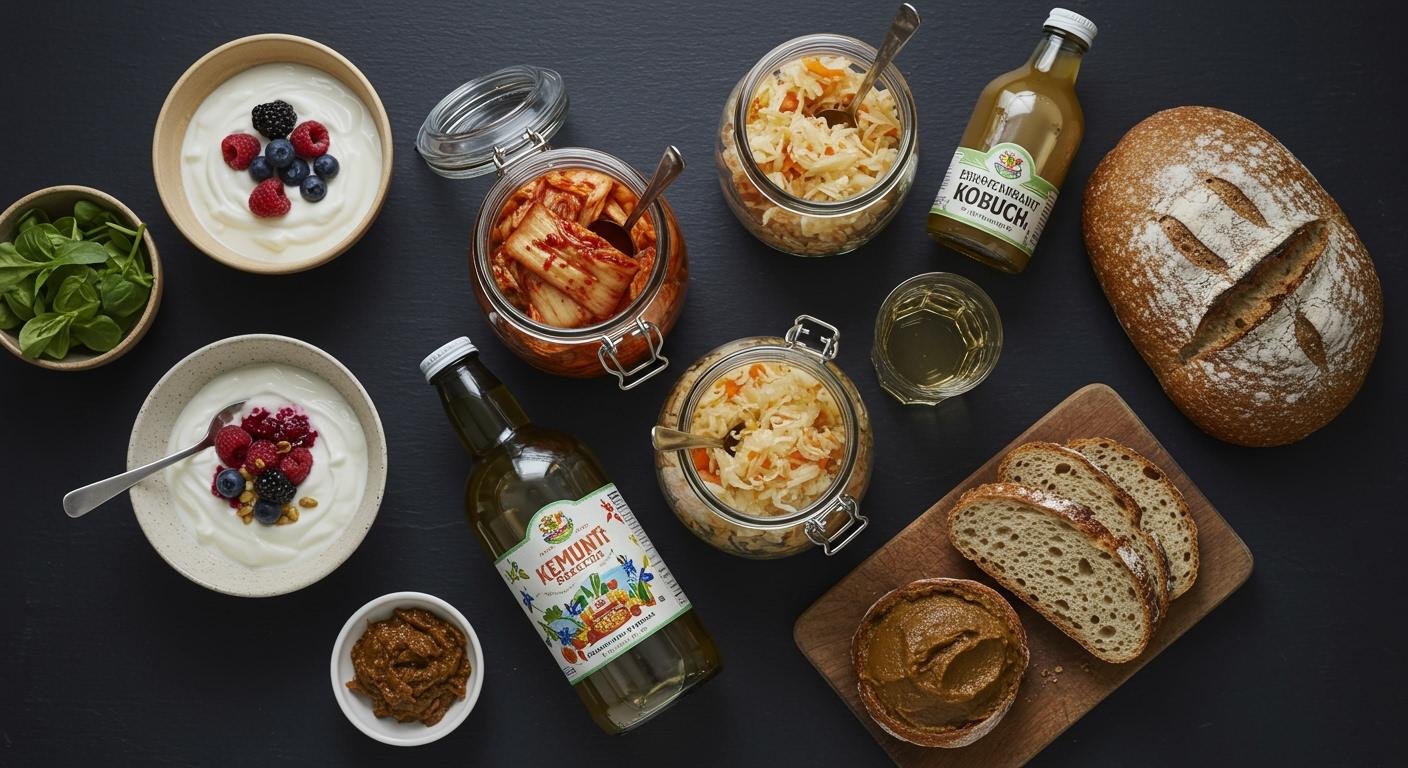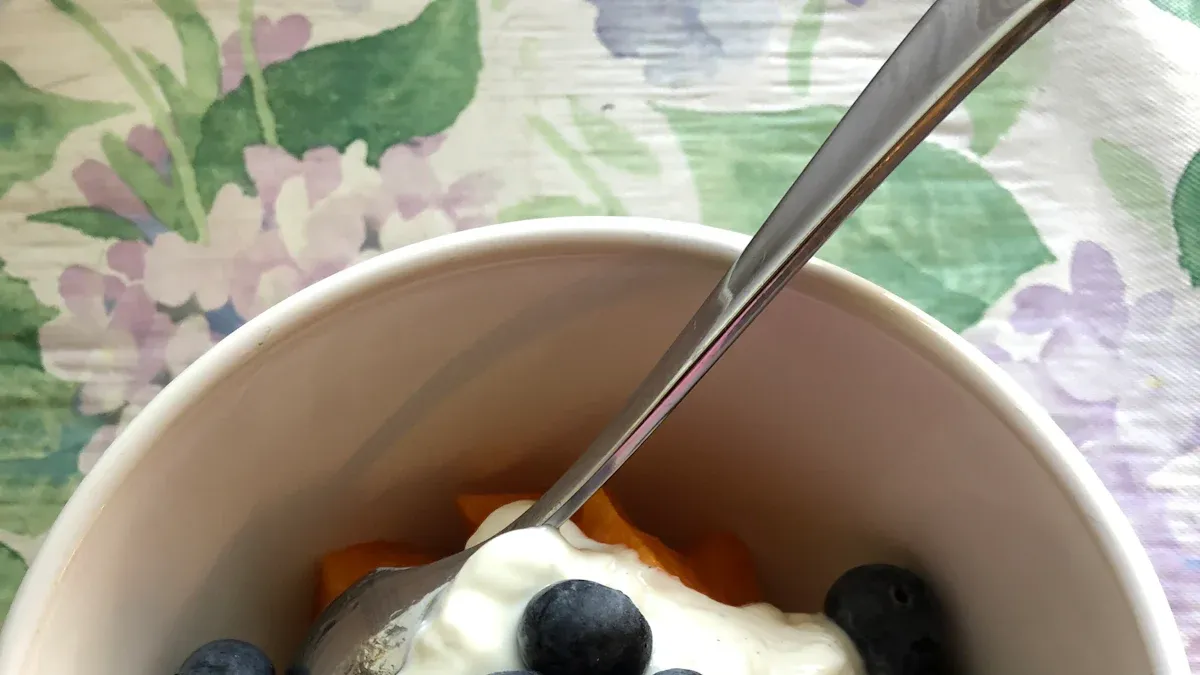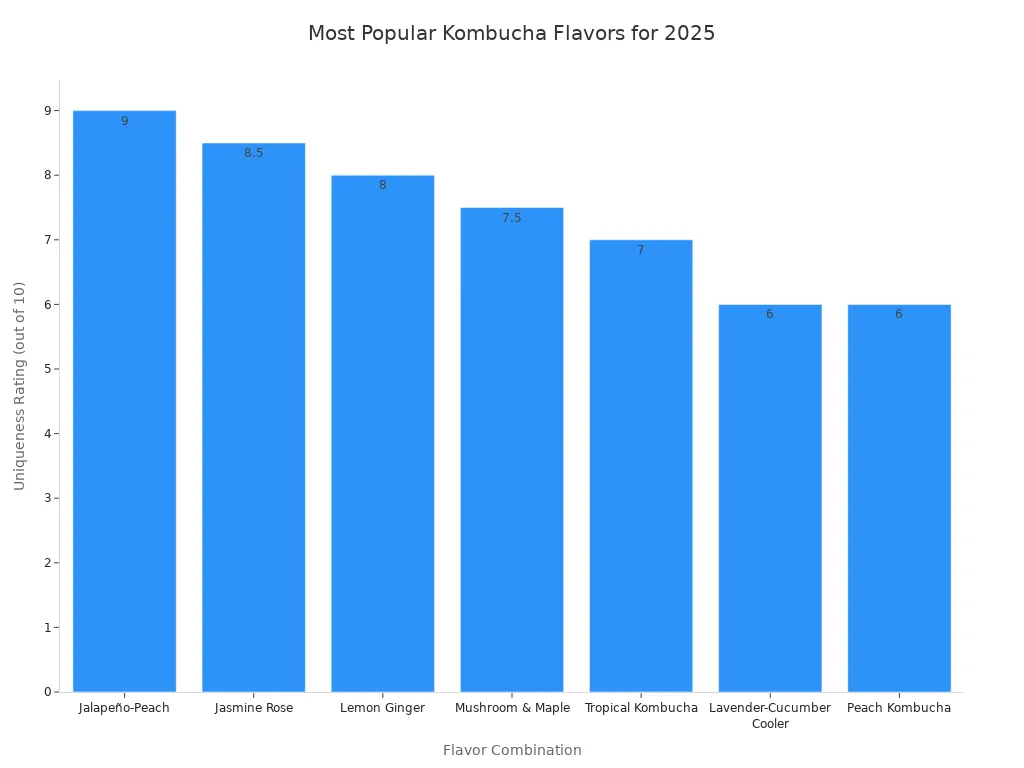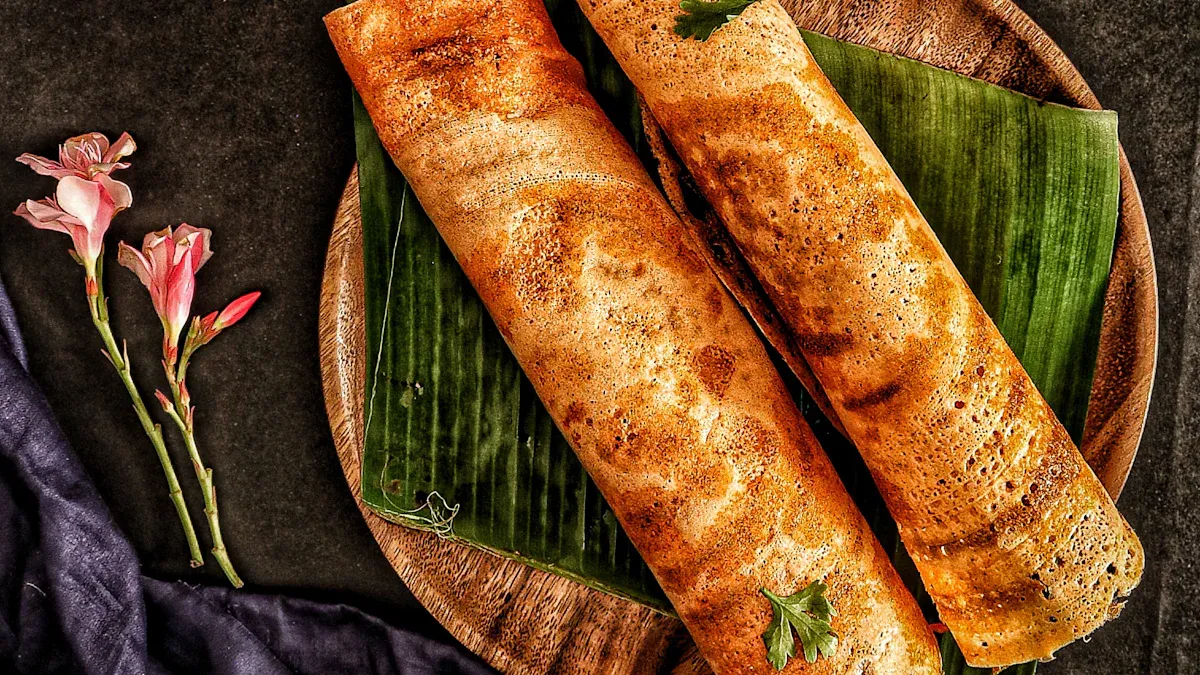Your Guide to Fermented Foods in 2025
Table of Contents

Get ready for a flavor adventure in 2025! 🥳 Foods like kimchi, kombucha, and kefir are becoming superstars. You might be one of the many Americans seeking better gut health. This growing interest is why the global fermented foods market is set to reach a massive $259.27 billion.
Fermentation is a simple, natural process. Tiny
good bacteriatransform foods, unlocking amazing flavors and health benefits with probiotics.
This guide helps you explore a variety of fermented foods, from tangy sauerkraut to creamy kefir.
ESSENTIAL FERMENTED FOODS FOR BEGINNERS:

Ready to dip your toes into the world of fermented foods? You don’t have to start with anything too wild. These beginner-friendly options are delicious, easy to find, and a fantastic way to support your gut health.
KEFIR AND YOGURT: TOP PROBIOTIC FOODS:
You probably already know and love yogurt. Kefir is its drinkable cousin! Think of it as a tangy, slightly fizzy smoothie. Both are probiotic foods made from fermented milk, and they are powerhouses for your health.
Regular yogurt gives you key good bacteria like Lactobacillus bulgaricus and Bifidobacteria. But kefir is a true microbiome champion, containing a huge variety of beneficial bacteria and yeasts, including strains like:
- Lactobacillus kefiri
- Lactococcus lactis
- Saccharomyces cerevisiae
These tiny helpers offer amazing health benefits. Studies show that regularly consuming probiotic foods like kefir may help with blood sugar control and even support weight loss goals. Most importantly, they are fantastic for improving digestion and building a healthy gut microbiome.
Easy Ways to Enjoy Kefir and Yogurt:
- Morning Smoothie: Blend kefir or yogurt with your favorite frozen fruit for a quick, probiotic-packed breakfast.
- Creamy Dressing: Use plain kefir as a base for a tangy ranch or caesar salad dressing.
- Overnight Oats: Soak oats in yogurt or kefir overnight for a gut-friendly start to your day.
- Simple Snack: Just grab a spoon! A bowl of yogurt with a drizzle of honey is a perfect simple treat.
SAUERKRAUT AND KIMCHI:
Let’s talk about fermented cabbage! Sauerkraut is a German classic made simply with cabbage and salt. It has a clean, sour, and salty flavor. Kimchi is a spicy Korean staple, and it takes things up a notch with ingredients like garlic, ginger, and Korean chili. This gives kimchi a complex flavor that’s spicy, sour, and savory all at once.
Both are excellent for your health, but their nutrition profiles differ slightly. Kimchi’s extra ingredients often give it a boost in certain vitamins.
Here’s a quick nutrition comparison for a one-cup serving:
| Nutrient | Sauerkraut | Kimchi |
|---|---|---|
| Calories | 27 | 23 |
| Vitamin C | 23% DV | 22% DV |
| Vitamin K | 15% DV | 55% DV |
| Iron | 12% DV | 21% DV |
| Sodium | 943 mg | 747 mg |
Don’t just think of them as a side dish! You can add sauerkraut or kimchi to almost anything for a punch of flavor and a dose of probiotics. Try adding a spoonful of sauerkraut to your next grilled cheese or topping a baked potato with it. Kimchi is amazing in fried rice, on tacos, or even mixed into scrambled eggs.
KOMBUCHA: THE TRENDY FERMENTED TEA:
You’ve likely seen bottles of kombucha lining grocery store shelves. This fizzy, fermented beverage is made from sweetened tea and a culture of bacteria and yeast. The result is a tangy, refreshing drink that has become incredibly popular.
One common question is about alcohol. Because it’s a fermented product, kombucha does contain trace amounts of alcohol. However, commercial kombucha sold in stores must legally contain less than 0.5% alcohol to be classified as non-alcoholic.
While kombucha offers probiotics and can be a great part of a healthy diet, it’s good to be aware of a few things. Some brands add a lot of sugar, which can lead to excess calories. The natural acidity can also be tough on tooth enamel, and drinking too much might cause digestive upset. People with compromised immune systems and women who are pregnant or breastfeeding should be cautious with unpasteurized fermented foods like kombucha.
The best part about kombucha is the flavor explosion! Looking ahead to 2025, you can expect to see some exciting combinations.
Hot Selling Kombucha Flavors for 2025
| Category | Flavor Combination |
|---|---|
| Top Sellers | Berry Lemonade, Pink Lady Apple, Passionfruit-Tangerine |
| Health-Focused | Elderberry Syrup, Raw Honey, Butterfly Pea Flower |
| Spicy & Sweet | Jalapeño-Peach |
Curious about which flavors are turning heads? Here’s a look at the most unique flavor combinations gaining popularity.

Whether you choose a creamy yogurt, tangy sauerkraut, or a fizzy kombucha, you’re taking a delicious step toward better health and nutrition.
FERMENTED FOODS FROM AROUND THE WORLD:

Ready to take your taste buds on a trip? The world of fermented foods is vast and delicious. You can explore amazing flavors right from your kitchen. Let’s look at some incredible fermented foods from around the world that you should try in 2025.
MISO AND TEMPEH:
You might have heard of miso soup, but this Japanese staple is so much more! Miso is a fermented paste made from soybeans. It delivers a powerful punch of savory, umami flavor. Tempeh is its cousin from Indonesia. It’s a firm cake of fermented soybeans with a nutty, earthy taste. Both are fantastic plant-based protein sources.
The fermentation process for these foods unlocks incredible health benefits. It breaks down antinutrients in soy, making it easier for your body to absorb all the good stuff. This means you get more protein, vitamins, and minerals. Good gut health is another major plus!
Did You Know? Food historians believe Javanese people created tempeh centuries ago. The earliest written mention appears in an early 19th-century Javanese text, describing dishes made with it.
Choosing the right miso can feel tricky, but it’s simple once you know the basics. The color tells you a lot about the flavor.
| Miso Type | Color | Fermentation | Flavor Profile | Best For |
|---|---|---|---|---|
| White Miso (Shiro) | Pale yellow | Shortest | Mild, delicate, and slightly sweet | Soups, dressings, and light marinades |
| Yellow Miso (Shinshu) | Light brown | Longer than white | Earthy and slightly salty | All-purpose use, from glazes to soups |
| Red Miso (Aka) | Red to dark brown | Longest | Bold, salty, and rich in umami | Hearty dishes like stews and braises |
You can find miso paste and tempeh in the refrigerated section of most grocery stores, often near the tofu and other plant-based proteins. Try using tempeh as a meat substitute in stir-fries or sandwiches. A spoonful of miso can transform a simple salad dressing or vegetable glaze.
KVASS: EASTERN EUROPEAN BREW:
Let’s travel to Eastern Europe for a taste of kvass. This traditional fermented beverage has been popular for over a thousand years, especially in Russia, Ukraine, and Poland. It was historically a drink for everyone, from peasants to nobility. Kvass is traditionally made from rye bread, giving it a unique, slightly sour, and earthy flavor that resembles a non-alcoholic beer.
People originally made kvass with simple ingredients:
- Rye bread (the star of the show!)
- Water
- Sugar or honey
- Yeast
- Sometimes fruits like berries or herbs like mint for extra flavor
While it is a fermented drink, its alcohol content is typically very low, similar to kombucha. Kvass is more than just a drink; it’s a piece of cultural history. It served as a safe alternative to water and a source of nutrition for centuries. You can find bottled kvass in international markets, or you can even try making it at home.
DHOKLA: INDIAN FERMENTED SNACK:
Looking for a light, savory, and healthy snack? Meet dhokla! This popular dish comes from Gujarat, India. It’s a soft, spongy cake made from a fermented batter of chickpea flour and sometimes rice flour. The fermentation gives dhokla its signature tangy taste and airy texture.
To make it, you typically mix chickpea flour with water and a starter like yogurt. You then let the batter ferment for several hours. This process creates natural probiotics and makes the nutrition in the chickpeas easier to digest. After fermenting, you steam the batter and top it with a sizzle of mustard seeds and cilantro.
Dhokla is a fantastic choice for a healthy snack. It’s low in calories and high in protein and fiber. Here’s a quick look at its nutrition profile.
| Nutrient (per serving) | Amount |
|---|---|
| Energy | ~195 kcal |
| Protein | 5.5 g |
| Fiber | 5.1 g |
| Fat | 5.2 g |
You can find dhokla mix in most Indian grocery stores, which makes it super easy to prepare. Enjoy it as a light breakfast, an afternoon snack, or a side dish. It’s a delicious way to enjoy the benefits of fermented foods.
FERMENTED FOODS FOR YOUR HEALTH AND ADVENTURE:
Are you feeling brave? This section covers fermented foods for your health and adventurous palate. These options offer unique flavors and powerful health benefits, but they might challenge your senses. Let’s dive into some of the world’s most fascinating fermented foods.
NATTŌ: JAPAN’S SUPERFOOD:
You may have heard whispers about nattō, a Japanese breakfast staple. It’s made from soybeans fermented with the bacterium Bacillus subtilis. This process gives it a very strong smell and a famously sticky, stringy texture. While it might seem intimidating, nattō is a true superfood packed with nutrition.
The biggest star in nattō is Vitamin K2. This vitamin is crucial for your health. It helps your body move calcium to your bones and teeth, keeping it out of your arteries. Studies show that people in eastern Japan, who eat a lot of nattō, have much higher Vitamin K2 levels and lower rates of hip fractures. These amazing health benefits make it a fantastic food for bone and heart health.
Tips for Trying Nattō:
- Start with otsubu nattō (large beans), which is less sticky.
- Mix it with rice and add soy sauce or mustard.
- Stir it into a hot bowl of miso soup to make the texture less noticeable.
SURSTRÖMMING: SWEDEN’S PUNGENT DELICACY:
Get ready to hold your nose! 👃 Surströmming is a Swedish fermented herring famous for having one of the most powerful smells in the food world. This tradition started centuries ago when salt was expensive. People couldn’t afford to fully preserve their fish, so they used just enough salt to start a fermentation process. This method kept the herring edible for months. A legend even says that Swedish fishermen first sold the “sour” herring in Finland, and the locals loved it!
KIVIAK: AN ARCTIC TRADITION:
For the ultimate food adventurer, there is kiviak. This is a traditional winter food from Greenland. It is a true testament to survival in a harsh climate. The preparation is unlike anything else.
- First, hundreds of small sea birds called auks are packed into a hollowed-out seal skin.
- All the air is pressed out, and the skin is sewn shut and sealed with fat.
- The bundle is then buried under rocks to ferment for several months.
Kiviak is a festive dish, often enjoyed during celebrations. It’s a unique part of Greenland’s culinary heritage and a powerful example of how fermented foods have helped people thrive around the world. Exploring these foods is a great way to support your gut health and experience global cultures. From creamy kefir to spicy kimchi, there is a fermented food for everyone.
Exploring fermented foods in 2025 is an exciting journey for your taste buds and your gut health. You can find a fermented food for every palate, from creamy kefir to spicy kimchi. These foods offer amazing health benefits and delicious new flavors for your meals. Are you ready to start?
Your challenge this week: Pick one new fermented food to try! Next time you’re at the store, grab a jar of sauerkraut. Add a spoonful to your next sandwich—your gut will thank you! 😉
FAQ
### Can I eat too many fermented foods?
Yes, you can have too much of a good thing! Your body needs time to adjust to all the new probiotics.
Our Tip: Start with small servings, like a spoonful of kimchi or a few sips of kefir. Listen to your body and slowly increase how much you eat.
### Should I buy pasteurized or unpasteurized products?
You should look for “unpasteurized” or “raw” on the label. The pasteurization process uses heat to kill bacteria. This process kills both the bad and the good probiotic bacteria you want. Unpasteurized foods contain live, active cultures.
### Do I need to refrigerate fermented foods?
Yes, you definitely should! Refrigeration slows down the fermentation process. This keeps your food from becoming too sour and preserves its flavor and probiotic content. Always keep them chilled. 🥶
### Are there any side effects to eating fermented foods?
You might notice some gas or bloating when you first start. This is usually normal. It’s just a sign that your gut microbiome is changing. These effects typically go away as your body gets used to the new foods.

Poseidon
Master of Nutritional Epidemiology, University of Copenhagen, Herbal Functional Nutrition Researcher
Focus: The scientific application of natural active ingredients such as Tongo Ali, Horny Goat Weed, and Maca to sexual health and metabolic regulation.
Core Focus:
Men: Use a combination of Tongo Ali (an energizing factor) + Maca (an energy reserve) to improve low energy and fluctuating libido.
Women: Use a combination of Horny Goat Weed (a gentle regulator) + Maca (a nutritional synergist) to alleviate low libido and hormonal imbalances.
Stressed/Middle-Aged Adults: This triple-ingredient synergy supports metabolism, physical strength, and intimacy.
Product Concept:
Based on traditional applications and modern research (e.g., Tongo Ali promotes testosterone-enhancing enzyme activity, and icariin provides gentle regulation), we preserve core active ingredients and eschew conceptual packaging—using natural ingredients to address specific needs.
Simply put: I'm a nutritionist who understands "herbal actives." I use scientifically proven ingredients like Tongo Ali, Epimedium, and Maca to help you make "sexual health" and "nutritional support" a daily routine.
